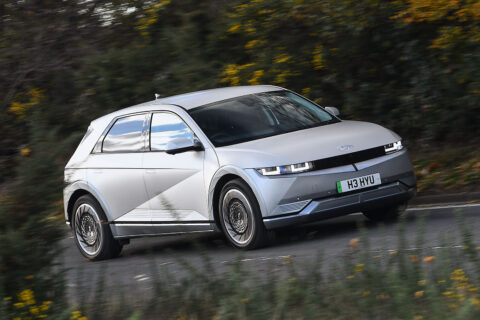
The Ioniq 5 might either be described as pretty unremarkable in this section, or surprisingly fast, depending on which version you buy. In spite of its modest power hike, our mid-range single-motor model is now markedly less powerful than an equivalent Polestar 2, and less powerful still than a single-motor Tesla Model Y – so it starts at a bit of a competitive disadvantage. But you’d never really guess as much from the way it goes about its business.
On a chilly day at the test track, our test car got away from rest under full power smoothly but urgently enough, and without troubling its traction control. It hit 60mph in 7.5sec, only a couple of tenths behind Hyundai’s official 0-62mph claim. A single-motor Polestar 2 is now a sub-6.0sec prospect over the same trip, though, and over the 30-70mph ‘motorway slip road’ acceleration test, it’s fully a second and a half quicker than this Hyundai.
While there are times at faster cruising speeds when the Ioniq 5 begins to feel like it could use just a little more power, most of the time it picks up speed with plenty of authority. Most testers agreed, however, that they’d expect the less powerful, entry-level 58kWh model to feel a little exposed at higher speeds and would be likely to avoid it with regular motorway driving in mind.
You can choose from Eco, Normal and Sport driving modes for the car and it has usefully clear graphical instrumentation on its all-digital binnacle screen to tell you when you’re drawing power from the battery, when you’re coasting, and exactly when you’re regenerating energy.
You can adjust ‘trailing throttle’ energy regen settings – from maximum regen to maximum coasting – using shift-style paddles behind the steering wheel; or select an automatic setting in which the car will decide for itself, using its forwards radar sensors, when and how much to engine brake to harvest energy; or, as a third option, you can choose an i-Pedal driving mode, in which the car adopts a one-pedal mode of operation that means you don’t need the brake pedal much at all.
This results in quite a marked difference in the car’s drivability depending on how it’s configured. Depending on your chosen mode, and also the condition of the drive battery, you’ll find that, at times, the car will coast along on a lifted throttle and it won’t regenerate under lighter braking either. Brake feel is quite cleverly managed, though, so that the pedal response is consistent – and reasonably progressive, albeit a little soft and synthesised in its feel – whether it’s actuating the friction brakes, blending in motor regen, or doing both.
It is to Hyundai’s credit, then, that this is an EV that you can drive exactly as you would choose to – with either lots of battery regen or almost none at all – and with linear responses from both motor and brakes, and a decently authoritative if not overly spritely performance level overall. Few rivals give the driver so many options to tailor the driving experience to their preference.
For assisted driving technology, meanwhile, Hyundai fits an autonomous emergency braking system with both pedestrian and cyclist detection as standard; a Highway Drive Assist active cruise control system, with active lane keeping assist as well, on all trim levels; and a reversing collision avoidance system and blindspot monitoring on upper trim levels.
The lane keeping systems are easy to turn on and off via a button on the steering wheel, and while there’s a speed limit detection system with speeding buzzer, it’s an unusually unintrusive one. Similarly, the driver monitoring system is quite unintrusive (there are no in-cabin cameras here checking which way the driver’s looking) – and the stability and traction controls can be fully (rather than only partly) deactivated via a physical button on the fascia, rather than by diving into the touchscreen menus.
